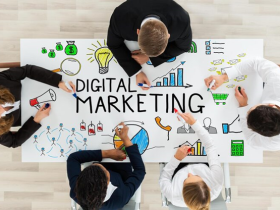The most obvious advantage of digital accessibility is that it allows people with disabilities to access information, goods, and services on a website. However, the benefits of digital accessibility extend beyond assisting those with disabilities. Some of these advantages might surprise you.
Knowing the advantages of digital accessibility for your organization, workers, and customers will not only assist your business but will also help you learn more about the world and how you can change it. For assistance with your material, don’t hesitate to get in touch with the QualityLogic team.
They believe that accessibility is a human right and want to guarantee that all businesses adhere to such standards in the future. When you work with them, they will review your website to determine what is missing so that they can work with you to create a game plan. Their team will collaborate with your people to guide and coach you all in the proper direction.
As you read, you will discover several compelling reasons why you should seek their guidance, even if you want to get started with their starter package.
Avoiding Potential Issues and Discrimination
As the internet and other digital technologies become more common in everyday life, it’s easy to argue that people with disabilities have the right to use them. According to the Americans with Disabilities Act, people with disabilities should have equal access to public services and “places of public accommodation,” such as restaurants, movie theaters, and schools (ADA).
Despite the fact that the ADA does not specifically address digital accessibility, the Act is vague enough that it is commonly assumed to apply to the digital sphere. The US Department of Justice has decided that several court processes involving difficult-to-use websites may have violated the Americans with Disabilities Act (ADA).
Businesses should apply Web Content Accessibility Guidelines and other digital accessibility standards to prevent discrimination claims and lawsuits (WCAG). They may also receive a letter stating that their website has been reviewed and reasonable changes have been made to make it accessible to people with disabilities.
The Name and Products of Your Company Should Be Well-Known
Hearing, vision, movement, and reasoning difficulties are only a few examples of impairments. According to the Centers for Disease Control and Prevention, one out of every four American adults is disabled (CDC).
Increasing the usability of your website is a wise business move. Although it is challenging to develop a website that everyone can use, a few simple changes may make it much easier for people with disabilities to access your site. Furthermore, accessibility features like transcripts and closed captions, mobile device compatibility, and a clean, simple design will help all users, not just those with disabilities.
People’s Perceptions of Your Company May Improve
People with disabilities, those who help them, and those who care about them all benefit from digital accessibility. Advocating for digital accessibility may boost the image of your firm. People with disabilities are more likely to tell their family, friends, and social media contacts about a positive experience they had with your company.
Creating an accessibility statement is one way to get a lot of attention for your website. This paper describes your dedication to digital accessibility and the measures you’ve taken to ensure that individuals with impairments can use your site, such as adhering to WCAG standards.
SEO (Search Engine Optimization) Improves
An accessible website is easier for customers to use and enhances SEO, making it easier to find. SEO increases the number of visitors to your website by raising its ranking in search engines such as Google. Despite the fact that Google’s ranking algorithm is never fully disclosed, almost all digital marketers agree on basic SEO best practices.
Most of the time, SEO objectives and digital accessibility objectives are in sync. Websites with easier-to-use interfaces can assist impaired users and lower the number of people who quit the site.
Consider how providing closed captions and transcripts for your content is required by both SEO and digital accessibility. Text versions of the video and audio recordings must be made available to everyone, including those with disabilities, according to digital accessibility standards like WCAG.
Because Google and other search engines are primarily interested in text, they will be unable to search for a voice in your video and audio recordings. Closed captions and transcripts aid SEO by containing language that Google and other search engines can understand and index. This makes it easier to find relevant content on your website.
Items Are Simplified
Usability and digital access, like SEO and digital access, are closely intertwined. Making things, places, and services more accessible to people with disabilities is what accessibility is all about. As a result, accessibility is linked to or overlaps with the concept of usability, which is focused on making a product or service more user-friendly and helpful.
Websites, for example, must adhere to digital accessibility standards such as WCAG in order to be usable and navigable. More people will visit your website if it is simple to use with a keyboard. If this criterion is met, your website’s navigational components are organized such that all users may easily find what they’re looking for.
More digital accessibility suggestions will make your website easier to use in general. Those with slow Internet connections can access material before it is completely loaded by using alternate text for photographs and other components of a website. A dictionary of acronyms, unusual words, and technical terms may help anybody, especially those with cognitive impairments or who use English as a second language.
Improves Code Reliability
Better code will benefit your website in a number of ways, including enhanced user experience, bug reduction, and faster site loading. This will also help your SEO ranking. Investing in accessibility is thus an investment in the future of your organization and code base.
This might be the most worrisome element, particularly if your IT department is small or if you are the IT department. In this case, it is critical to contact a digital accessibility team, such as QualityLogic. We can assist you in continuing or beginning your journey toward full accessibility. Whatever you require, we are here to assist you.
Conclusion
One of the most common misconceptions about digital accessibility is that it only benefits the disabled. As we discussed in this article, digital accessibility may help you get more customers, improve how people see your company, climb search engine rankings, and make your website easier to use. All of these are significant business advantages that also aid in website discovery.
Many of the measures you may take to make your website more accessible benefit people who are not visually impaired. You must be familiar with digital technology. All of these tools, and more, are available from QualityLogic. Click here to learn about their digital accessibility approach, which will give you greater confidence in employing them. Keep an eye on your brand’s and clients’ growth.






